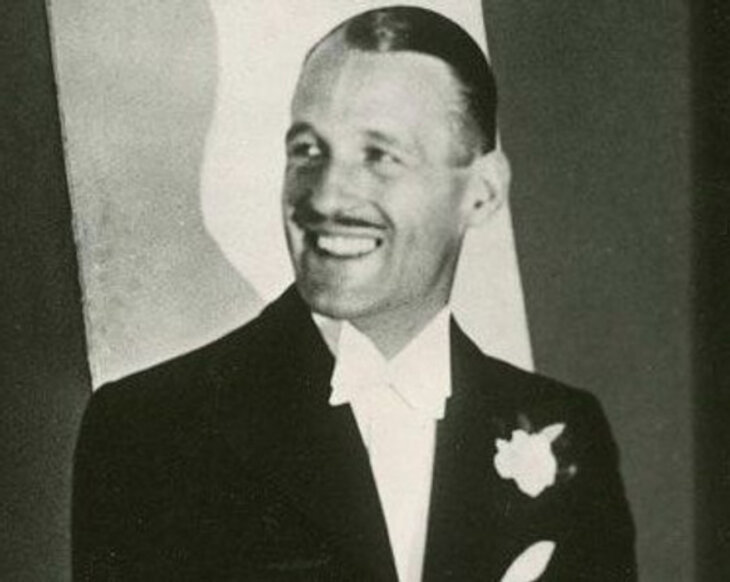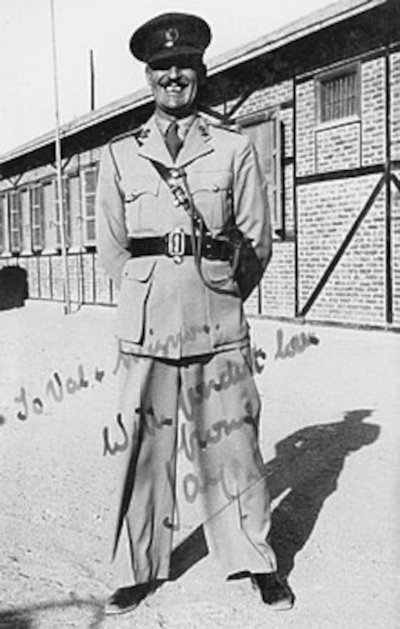 An Open Letter to University Presidents
An Open Letter to University Presidents


7 min read
The battle against the Nazis relied on machinery, manpower, money, and even a bit of magic.
Jasper Maskelyne, a celebrated British magician and illusionist, is credited by many historians with having devised several fantastic acts of camouflage and stage illusions that helped turn the tide against the Germans, especially during key battles in North Africa.
Magic was in his genes. For more than 60 years, the Maskelyne family, including his father and grandfather, had been considered Britian’s “the first family of conjuring.” Jasper’s father, John, devised the famous Box Trick, in which a female assistant vanished from a sealed and inspected cabinet, along with other tricks that became standard.
 Jasper Maskelyne
Jasper Maskelyne
On February 14, 1941, when German troops rode into Tripoli with nearly unstoppable force, they already controlled nearly all of North Africa. That same evening, Jasper Maskelyne was on stage, appearing to swallow a succession of razor blades in front of his mesmerized audience. As London theaters emptied due to the war, Maskelyne tried to enlist, but at 37, he was considered too old and dismissed as merely a conjurer. But the magician was determined to play a role. As he wrote, “The outbreak of the war foretold inevitable misery to everyone. To me, it involved something very strange and rather alarming—the focusing of my whole imagination and knowledge on the problem of how best to mobilize the world of magic against Hitler.”
During a course with the Royal Engineers Camouflage Training and Development Center at Farnham Castle in Surrey, Maskelyne impressed an army inspector general by hiding a machine gun bunker in plain sight. After completing the program in January 1941, Maskelyne shipped out to North Africa with a dozen other camouflage officers, all with the rank of captain. At that time, war camouflage was being developed by engineers. Maskelyne was certain that if he could hide things in plain sight from an audience only an orchestra’s pit away, he could deceive German observers from a distance of 15,000 feet in the air or miles away on land.
In North Africa, the magician was expected to entertain the troops, but he also created a Camouflage Experimental Section, working with a hand-picked group that included a cartoonist, pottery worker, electrical engineer, chemist, and stage scenery designer. A History Channel documentary about Maskelyne referred to “the gang,” as they were known, as “undisciplined, unorthodox, and unwanted by the mainstream military establishment, but they had guts, glory, and imagination.”
The gang wasn’t called into action until June 1941. Then, British ships at Alexandria Harbor in Egypt became prime targets for the Luftwaffe, and Maskelyne was asked to make the harbor, comprised of hundreds of buildings and spanning many miles, “disappear.” Instead, he and the gang created a decoy harbor a few miles away, using mud, canvas, and cardboard. It was designed and lit to resemble Alexandria’s naval buildings, with ground lights connected to the Pharos Lighthouse (one of the seven wonders of the ancient world), where they could be controlled. Electric charges were set underground to simulate bomb explosions.
 A ‘sunshield’ covering half a Matilda II tank at a workshop of the Middle East Command Camouflage Development and Training Centre, Helwan, Egypt in 1941, as used in Operation Bertram.
A ‘sunshield’ covering half a Matilda II tank at a workshop of the Middle East Command Camouflage Development and Training Centre, Helwan, Egypt in 1941, as used in Operation Bertram.
On June 22, the British turned off all the lights in Alexandria but turned on the lights over the decoy harbor. The Luftwaffe took the bait, and as they flew over, the decoy ships were blown up by remote control. This convinced the Germans they had the right target, and they continued to drop bombs on the fake harbor for three nights running. Maskelyne was promoted to Major and earned the respect he craved from his superiors.
The magician also used optical illusions to help achieve victory. The Suez Canal--a vital link in the British supply chain--was under attack by the Germans. Maskelyne was asked to extend the range of 90 searchlights along the waterway so that British gunners could more easily spot oncoming enemy planes. Instead, Maskelyne used a trick of illusion that was already nearly a century old. He and the gang cut a series of reflective mirrors and attached them to searchlights, turning them into blinding strobe lights that could daze and temporarily blind enemy pilots. This dazzling set of beams, known as the Whirling Spray, would hide the Suez Canal in an ocean of blinding light.

When the Whirling Spray was ready, Maskelyne insisted on testing it personally. He climbed up into an RAF fighter plane which rose 15,000 above the African desert. When the gang on the ground turned on the spotlight, it did the job with nearly fatal results. The RAF pilot was temporarily blinded and he lost control of the plane. It began to plunge to earth, with the pilot managing a last-minute recovery, barely preventing a crash. The Whirling Spray lights dilated the eyes of many German pilots, and many planes went down. The Germans couldn’t penetrate the space where the Suez Canal had seemingly disappeared.
The battle for El Alamein was a crucial win for the Allies, and General Archibald Wavell asked Maskelyne to make tanks invisible to Germans in the desert. Flat, featureless, and completely open, the desert is a tough place for camouflage. Maskelyne’s gang designed “a sun shield,” two “wings” that closed over real tanks, making them appear to be innocent convoy vehicles. To rub out the tracks made by the tanks, they added a spiky chain mail device to make the tracks look like those from trucks.
General Wavell then amassed a huge convoy of “harmless transport” trucks opposite a weakness in the Italian front line, stopping an enemy offensive into Cairo before it began. Maskelyne was jubilant: “I danced with joy. War magic was coming into wartime fashion at last and I knew this was only the first example of what we could do.”
But by late June 1942, the Germans were still winning the African continent, having pushed the British army back 60 miles west of Alexandria. To create ambushes and confuse and trap the enemy, Maskelyne and the gang hid explosives in trails of camel and donkey dung along the roads. While hardly a grand illusion, it did the job.
The magician’s greatest success occurred in July 1942 during the battle over El Alamein, then under German control. Land, middle east oil, and the course of the war were all at stake. This battle would settle the fate of North Africa, and British Field Marshall Bernard Montgomery desperately needed to capture it back.
British supply lines were located in the north, but Allies wanted the Germans to expect an attack from the south. Maskelyne wrote, “The biggest drama in which I ever played a humble part was being played on a grand scale and villainy was already beginning to know that the final hour of reckoning was at hand.”
To create the illusion of an attack being planned in the south, “the gang” built dummy tanks, guns, aircraft, men, even a pipeline of steel cans.
 Inflatable dummy Sherman tank
Inflatable dummy Sherman tank
This decoy army was so convincing that the Germans placed their main forces nearby. Meanwhile, Maskelyne masterminded the real deception: thousands of soldiers and tanks—camouflaged as dummy transports--were being moved in plain view of enemy forces. When the British attacked in the north as planned on October 23, Germany’s Field Marshall Erwin Rommel, known as the Desert Fox, had been outfoxed. The ill-prepared German forces retreated to Libya and the British savored their first real victory of the war. This was Jasper Maskelyne’s last grand illusion in the desert, turning a stalemate into a tremendous victory for British forces, psychologically and militarily.
 Jasper Maskelyne (on the right) and his magic troupe departing from Nairobi in 1950.
Jasper Maskelyne (on the right) and his magic troupe departing from Nairobi in 1950.
After the war Maskelyne returned to England and to the stage. He asked for and received permission to continue to dress in British Army uniform when performing on stage again. Though he wrote an autobiography, Jasper Maskelyne never revealed his magician’s secrets. In fact, his subterfuges and war illusions are classified as top secret by the Official Secrets Act, not to made public till 2046.

By the way most of his claimed acts are well accepted to be made up for his own self promotion. The detail about the Pharos lighthouse was a big oversight in the lie setting as it has not existed for hundreds of years. Any contributions he truly made to the war were minor.
see https://allthatsinteresting.com/jasper-maskelyne
Why this article? Was he Jewish?
Not everyone needs to be Jewish to deserve recognition.
From what I recall reading, the Allied victory at El Alamein was very significant as that is what prevented the German army from continuing further north into Israel. So this article (and the facts that it contains) are very pertinent to the Jewish people.
It's not correct to say that he never revealed his magician's secrets. He wrote a book called Maskelyne's Book of Magic.
Yes, he did write a book on some magician's secrets, but none of them were on the level of what he did during the war.
thank you for the wonderful and even mind-blowing article!